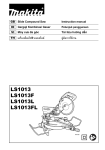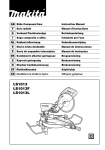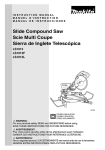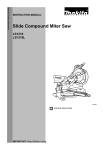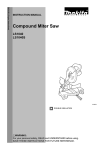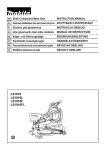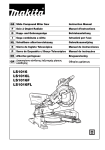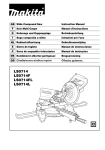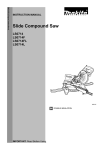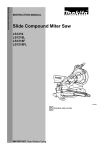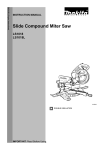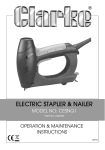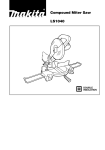Download Makita LS1013L Instruction manual
Transcript
ENGLISH (Original instructions) INSTRUCTION MANUAL Slide Compound Saw LS1013 LS1013F LS1013L LS1013FL 001529 DOUBLE INSULATION WARNING: For your personal safety, READ and UNDERSTAND before using. SAVE THESE INSTRUCTIONS FOR FUTURE REFERENCE. 1 ENGLISH SPECIFICATIONS Model LS1013 /LS1013F/ LS1013L/LS1013FL Blade diameter 250 mm - 260 mm Hole diameter For all countries other than European countries 25 mm and 25.4 mm For European countries 30 mm Max. Cutting capacities (H x W) with 260 mm in diameter Bevel angle Miter angle 0° 45° (left) 0° 45° (right) 50 mm x 310 mm 91 mm x 310 mm 31 mm x 310 mm 91 mm x 220 mm 31 mm x 220 mm 91 mm x 190 mm - (left) 50 mm x 200 mm 45° (right) 50 mm x 220 mm 52° (right) - No load speed (min-1) 3,700 Laser Type (LS1013L/LS1013FL only) Red Laser 650 nm, Dimensions (L x W x H) 1mW ( Laser Class 2 ) LS1013/LS1013F…….715 mm x 520 mm x 625 mm LS1013L/LS1013FL …….715 mm x 520 mm x 640 mm Net weight LS1013: 22.4 kg, LS1013F: 22.6 kg, LS1013L: 23.2 kg, LS1013FL: 23.4 kg /II Safety class • Due to our continuing programme of research and development, the specifications herein are subject to change without notice. • Specifications may differ from country to country. • Weight according to EPTA-Procedure 01/2003 ・ END216-3 Symbols The following show the symbols used for the equipment. Be sure that you understand their meaning before use. ・ Read instruction manual. ・ DOUBLE INSULATION ・ To avoid injury from flying debris, keep holding the saw head down, after making cuts, until the blade has come to a complete stop. ・ When performing slide cut, first pull carriage fully and press down handle, then push carriage toward the guide fence. Do not place hand or fingers close to the blade. For your safety, remove the chips, small pieces, etc. from the table top before operation. Always set SUB-FENCE to left position when performing left bevel cuts. Failure to do so may cause serious injury to operator. ・ ・ ・ ・ ・ Always remove SUB-FENCE R when performing right bevel cuts. Failure to do so may cause serious injury to operator. Never look into the laser beam. Direct laser beam may injure your eyes. Only for EU countries Do not dispose of electric equipment together with household waste material! In observance of European Directive 2002/96/EC on waste electric and electronic equipment and its implementation in accordance with national law, electric equipment that have reached the end of their life must be collected separately and returned to an environmentally compatible recycling facility. ENE006-1 Intended use The tool is intended for accurate straight and miter cutting in wood. With appropriate saw blades, aluminum can also be sawed. ENF002-1 Power supply The tool should be connected only to a power supply of the same voltage as indicated on the nameplate, and can only be operated on single-phase AC supply. They are double-insulated in accordance with European 2 ENA001-2 Standard and can, therefore, also be used from sockets without earth wire. SAFETY INSTRUCTIONS ENG102-3 WARNING! When using electric tools, basic safety precautions, including the following, should always be followed to reduce the risk of fire, electric shock and personal injury. Read all these instructions before operating this product and save these instructions. Noise The typical A-weighted noise level determined according to EN61029: Sound pressure level (LpA) : 88 dB(A) Sound power level (LWA) : 101 dB(A) Uncertainty (K) : 3 dB(A) Wear ear protection For safe operations: ENG238-1 1. Vibration The vibration emission value determined according to EN61029 : Vibration emission (ah) : 2.5 m/s2 or less Uncertainty (K) : 1.5 m/s2 2. ENH003-11 For European countries only 3. EC Declaration of Conformity We Makita Corporation as the responsible manufacturer declare that the following Makita machine(s): Designation of Machine: Slide Compound Saw 4. Model No./ Type: LS1013, LS1013F, LS1013L,LS1013FL are of series production and Conforms to the following European Directives: 98/37/EC until 28th December 2009 and then with 2006/42/EC from 29th December 2009 And are manufactured in accordance with the following standards or standardised documents: EN61029 The technical documentation is kept by our authorised representative in Europe who is: Makita International Europe Ltd, Michigan, Drive, Tongwell, Milton Keynes, MK15 8JD, England 5. 6. 7. 8. 30th January 2009 9. 000230 Tomoyasu Kato Director Makita Corporation 3-11-8, Sumiyoshi-cho, Anjo, Aichi, JAPAN 10. 11. 12. 3 Keep work area clean. Cluttered areas and benches invite injuries. Consider work area environment. Do not expose power tools to rain. Do not use power tools in damp or wet locations. Keep work area well lit. Do not use power tools where there is risk to cause fire or explosion. Guard against electric shock. Avoid body contact with earthed or grounded surfaces (e.g. pipes, radiators, ranges, refrigerators). Keep children away. Do not let visitors touch the tool or extension cord. All visitors should be kept away from work area. Store idle tools. When not in use, tools should be stored in a dry, high or locked up place, out of reach of children. Do not force the tool. It will do the job better and safer at the rate for which it was intended. Use the right tool. Do not force small tools or attachments to do the job of a heavy duty tool. Do not use tools for purposes not intended; for example, do not use circular saws to cut tree limbs or logs. Dress properly. Do not wear loose clothing or jewellery, they can be caught in moving parts. Rubber gloves and non-skid footwear are recommended when working outdoors. Wear protecting hair covering to contain long hair. Use safety glasses and hearing protection. Also use face or dust mask if the cutting operation is dusty. Connect dust extraction equipment. If devices are provided for the connection of dust extraction and collection facilities ensure these are connected and properly used. Do not abuse the cord. Never carry the tool by the cord or yank it to disconnect it from the socket. Keep the cord away from heat, oil and sharp edges. Secure work. Use clamps or a vice to hold the work. It is safer than using your hand and it frees both hands to 13. 14. 15. 16. 17. 18. 19. 20. 21. 22. ENB034-3 operate the tool. Do not overreach. Keep proper footing and balance at all times. Maintain tools with care. Keep cutting tools sharp and clean for better and safer performance. Follow instructions for lubrication and changing accessories. Inspect tool cord periodically and if damaged have it repaired by an authorized service facility. Inspect extension cords periodically and replace, if damaged. Keep handles dry, clean and free from oil and grease. Disconnect tools. When not in use, before servicing and when changing accessories such as blades, bits and cutters. Remove adjusting keys and wrenches. Form the habit of checking to see that keys and adjusting wrenches are removed from the tool before turning it on. Avoid unintentional starting. Do not carry a plugged-in tool with a finger on the switch. Ensure switch is off when plugging in. Use outdoor extension leads. When tool is used outdoors, use only extension cords intended for outdoor use. Stay alert. Watch what you are doing. Use common sense. Do not operate tool when you are tired. Check damaged parts. Before further use of the tool, a guard or other part that is damaged should be carefully checked to determine that it will operate properly and perform its intended function. Check for alignment of moving parts, free running of moving parts, breakage of parts, mounting and any other conditions that may affect its operation. A guard or other part that is damaged should be properly repaired or replaced by an authorized service center unless otherwise indicated in this instruction manual. Have defective switches replaced by an authorized service facility. Do not use the tool if the switch does not turn it on and off. Warning. The use of any accessory or attachment, other than those recommended in this instruction manual or the catalog, may present a risk of personal injury. Have your tool repaired by a qualified person. This electric tool is in accordance with the relevant safety requirements. Repairs should only be carried out by qualified persons using original spare parts, otherwise this may result in considerable danger to the user. ADDITIONAL SAFETY RULES FOR TOOL 1. 2. 3. 4. 5. 6. 7. 8. 9. 10. 11. 12. 13. 14. 15. 16. 17. 18. 19. 20. 4 Wear eye protection. Keep hands out of path of saw blade. Avoid contact with any coasting blade. It can still cause severe injury. Do not operate saw without guards in place. Check blade guard for proper closing before each use. Do not operate saw if blade guard does not move freely and close instantly. Never clamp or tie the blade guard into the open position. Do not perform any operation freehand. The workpiece must be secured firmly against the turn base and guide fence with the vise during all operations. Never use your hand to secure the workpiece. Never reach around saw blade. Turn off tool and wait for saw blade to stop before moving workpiece or changing settings. Unplug tool before changing blade or servicing. Always secure all moving portions before carrying the tool. Stopper pin which locks the cutter head down is for carrying and storage purposes only and not for any cutting operations. Do not use the tool in the presence of flammable liquids or gases. Check the blade carefully for cracks or damage before operation. Replace cracked or damaged blade immediately. Use only flanges specified for this tool. Be careful not to damage the arbor, flanges (especially the installing surface) or bolt. Damage to these parts could result in blade breakage. Make sure that the turn base is properly secured so it will not move during operation. For your safety, remove the chips, small pieces, etc. from the table top before operation. Avoid cutting nails. Inspect for and remove all nails from the workpiece before operation. Make sure the shaft lock is released before the switch is turned on. Be sure that the blade does not contact the turn base in the lowest position. Hold the handle firmly. Be aware that the saw moves up or down slightly during start-up and stopping. Make sure the blade is not contacting the workpiece before the switch is turned on. 21. 22. 23. 24. 25. 26. 27. 28. 29. 30. 31. 32. 33. 34. 35. 36. 37. Before using the tool on an actual workpiece, let it run for a while. Watch for vibration or wobbling that could indicate poor installation or a poorly balanced blade. Wait until the blade attains full speed before cutting. Stop operation immediately if you notice anything abnormal. Do not attempt to lock the trigger in the on position. Be alert at all times, especially during repetitive, monotonous operations. Do not be lulled into a false sense of security. Blades are extremely unforgiving. Always use accessories recommended in this manual. Use of improper accessories such as abrasive wheels may cause an injury. Do not use the saw to cut other than wood, aluminum or similar materials. Connect miter saws to a dust collecting device when sawing. Select saw blades in relation to the material to be cut. Take care when slotting. Replace the kerf board when worn. Do not use saw blades manufactured from high speed steel. Some dust created from operation contains chemicals known to cause cancer, birth defects or other reproductive harm. Some examples of these chemicals are: • lead from lead-based-painted material and, • arsenic and chromium from chemically-treated lumber. Your risk from these exposures varies, depending on how often you do this type of work. To reduce your exposure to these chemicals: work in a well ventilated area and work with approved safety equipment, such as those dust masks that are specially designed to filter out microscopic particles. To reduce the emitted noise, always be sure that the blade is sharp and clean. The operator is adequately trained in the use, adjustment and operation of the machine. Use correctly sharpened saw blades. Observe the maximum speed marked on the saw blade. Refrain from removing any cut-offs or other parts of the workpiece from the cutting area whilst the tool is running and the saw head is not in the rest position. INSTALLATION Bench mounting When the tool is shipped, the handle is locked in the lowered position by the stopper pin. Release the stopper pin by lowering the handle slightly and pulling the stopper pin. 1. Stopper pin 1 001564 This tool should be bolted with four bolts to a level and stable surface using the bolt holes provided in the tool's base. This will help prevent tipping and possible injury. 1. Bolt 1 001531 FUNCTIONAL DESCRIPTION • CAUTION: Always be sure that the tool is switched off and unplugged before adjusting or checking function on the tool. Blade guard 1. Blade guard 1 001535 When lowering the handle, the blade guard rises automatically. The blade guard returns to its original position when the cut is completed and the handle is raised. NEVER DEFEAT OR REMOVE THE BLADE SAVE THESE INSTRUCTIONS. 5 GUARD OR THE SPRING WHICH ATTACHES TO THE GUARD. In the interest of your personal safety, always maintain the blade guard in good condition. Any irregular operation of the blade guard should be corrected immediately. Check to assure spring loaded return action of guard. NEVER USE THE TOOL IF THE BLADE GUARD OR SPRING ARE DAMAGED, FAULTY OR REMOVED. DOING SO IS HIGHLY DANGEROUS AND CAN CAUSE SERIOUS PERSONAL INJURY. If the see-through blade guard becomes dirty, or sawdust adheres to it in such a way that the blade and/or workpiece is no longer easily visible, unplug the saw and clean the guard carefully with a damp cloth. Do not use solvents or any petroleum-based cleaners on the plastic guard. If the blade guard is especially dirty and vision through the guard is impaired, use the supplied socket wrench to loosen the hex bolt holding the center cover. Loosen the hex bolt by turning it counterclockwise and raise the blade guard and center cover. With the blade guard so positioned, cleaning can be more completely and efficiently accomplished. When cleaning is complete, reverse procedure above and secure bolt. Do not remove spring holding blade guard. If guard becomes discolored through age or UV light exposure, contact a Makita service center for a new guard. DO NOT DEFEAT OR REMOVE GUARD. 1 2 4 3 1. Saw blade 2. Blade teeth 3. Kerf board 4. Left bevel cut 5. Straight cut 6. Right bevel cut 5 6 001538 This tool is provided with the kerf boards in the turn base to minimize tearing on the exit side of a cut. The kerf boards are factory adjusted so that the saw blade does not contact the kerf boards. Before use, adjust the kerf boards as follows: First, unplug the tool. Loosen all the screws (2 each on left and right) securing the kerf boards. Re-tighten them only to the extent that the kerf boards can still be easily moved by hand. Lower the handle fully and push in the stopper pin to lock the handle in the lowered position. Loosen the knob which secures the slide poles. Pull the carriage toward you fully. Adjust the kerf boards so that the kerf boards just contact the sides of the blade teeth. Tighten the front screws (do not tighten firmly). Push the carriage toward the guide fence fully and adjust the kerf boards so that the kerf boards just contact the sides of blade teeth. Tighten the rear screws (do not tighten firmly). After adjusting the kerf boards, release the stopper pin and raise the handle. Then tighten all the screws securely. 1. Blade guard 1 001782 Positioning kerf board 1. Knob 2. Kerf board • 1 CAUTION: Before and after changing the bevel angle, always adjust the kerf boards as described above. Maintaining maximum cutting capacity Unplug the tool before any adjustment is attempted. This tool is factory adjusted to provide the maximum cutting capacity for a 255 mm saw blade. When installing a new blade, always check the lower limit position of the blade and if necessary, adjust it as follows: 2 001537 6 at the desired position when lowering the handle fully. 1. Adjusting bolt 2. Turn base 1 Adjusting the miter angle 1. Lock lever 2. Grip 3. Pointer 4. Miter scale 2 1 001539 2 1. Top surface of turn base 2. Periphery of blade 3. Guide fence 2 1 3 001541 Loosen the grip by turning counterclockwise. Turn the turn base while pressing down the lock lever. When you have moved the grip to the position where the pointer points to the desired angle on the miter scale, securely tighten the grip clockwise. 3 001540 • First, unplug the tool. Push the carriage toward the guide fence fully and lower the handle completely. Use the socket wrench to turn the adjusting bolt until the periphery of the blade extends slightly below the top surface of the turn base at the point where the front face of the guide fence meets the top surface of the turn base. With the tool unplugged, rotate the blade by hand while holding the handle all the way down to be sure that the blade does not contact any part of the lower base. Re-adjust slightly, if necessary. • 4 • CAUTION: When turning the turn base, be sure to raise the handle fully. After changing the miter angle, always secure the turn base by tightening the grip firmly. Adjusting the bevel angle To adjust the bevel angle, loosen the lever at the rear of the tool counterclockwise. Unlock the arm by pushing the handle somewhat strongly in the direction that you intend to tilt the saw blade. 1. Lever CAUTION: After installing a new blade, always be sure that the blade does not contact any part of the lower base when the handle is lowered completely. Always do this with the tool unplugged. 1 004056 Stopper arm 1 1. Adjusting screw 2. Stopper arm Tilt the saw blade until the pointer points to the desired angle on the bevel scale. Then tighten the lever clockwise firmly to secure the arm. 1. Arm 2. Lever 3. Pointer 4. Bevel scale 1 2 2 001562 The lower limit position of the blade can be easily adjusted with the stopper arm. To adjust it, rotate the stopper arm in the direction of the arrow as shown in the figure. Adjust the adjusting screw so that the blade stops 3 001543 7 4 • • • CAUTION: When tilting the saw blade, be sure to raise the handle fully. After changing the bevel angle, always secure the arm by tightening the lever clockwise. When changing bevel angles, be sure to position the kerf boards appropriately as explained in the "Positioning kerf boards" section. • • Switch action CAUTION: Before plugging in the tool, always check to see that the switch trigger actuates properly and returns to the "OFF" position when released. • When not using the tool, remove the lock-off button and store it in a secure place. This prevents unauthorized operation. • Do not pull the switch trigger hard without pressing in the lock-off button. This can cause switch breakage. For European countries • • Lighting up the lamps For Model LS1013F,LS1013FL only 2 1. Light 2. Light switch 1 1. Lock-off button 2. Switch trigger 3. Lever 1 WARNING: NEVER use tool without a fully operative switch trigger. Any tool with an inoperative switch is HIGHLY DANGEROUS and must be repaired before further usage. For your safety, this tool is equipped with a lock-off button which prevents the tool from unintended starting. NEVER use the tool if it runs when you simply pull the switch trigger without pressing the lock-off button. Return tool to a Makita service center for proper repairs BEFORE further usage. NEVER tape down or defeat purpose and function of lock-off button. 2 002026 CAUTION: This is not a rainproof light. Do not wash the light in water or use it in a rain or a wet area. Such a conduct can cause an electric shock and fume. • Do not touch the lens of the light, as it is very hot while it is lighted or shortly after it is turned off. This may cause a burn to a human body. • Do not apply impact to the light, which may cause damage or shorted service time to it. • Do not keep casting the beam of the light to your eyes. This can cause your eyes to be hurt. • Do not cover the light with clothes, carton, cardboard or similar objects while it is lighted, which can cause a fire or an ignition. Push the upper position of the switch for turning on the light and the lower position for off. 3 • 005228 To prevent the switch trigger from being accidentally pulled, a lock-off button is provided. To start the tool, push the lever to the left, press in the lock-off button and then pull the switch trigger. Release the switch trigger to stop. For all countries other than European countries 1 2 3 1. Lock-off button 2. Handle 3. Switch trigger 1 1. Light switch 001551 To prevent the switch trigger from being accidentally pulled, a lock-off button is provided. To start the tool, press in the lock-off button and pull the switch trigger. Release the switch trigger to stop. 003826 Move the light to shift an area of lighting. 8 Aligning the laser line NOTE: • Use a dry cloth to wipe the dirt off the lens of lamp. Be careful not to scratch the lens of light, or it may lower the illumination. A B Laser beam action For model LS1013L,LS1013FL only 1. Switch for laser 006341 Laser line can be shifted to either the left or right side of the blade according to the applications of cutting. Refer to explanation titled "Laser beam action" regarding its shifting method. 1 006339 NOTE: • Use wood facing against the guide fence when aligning the cutting line with the laser line at the side of guide fence in compound cutting (bevel angle 45 degrees and miter angle right 45 degrees). A) When you obtain correct size on the left side of workpiece • Shift the laser line to the left of the blade. B) When you obtain correct size on the right side of workpiece • Shift the laser line to the right of the blade. Align the cutting line on your workpiece with the laser line. CAUTION: • Never look into the laser beam. Direct laser beam may injure your eyes. • LASER RADIATION, DO NOT STARE INTO THE BEAM OR VIEW DIRECTLY WITH OPTICAL INSTRUMENTS, CLASS 2M LASER PRODUCT. To turn on the laser beam, press the upper position (I) of the switch. Press the lower position (O) to turn off. Laser line can be shifted to either the left or right side of the saw blade by adjusting the adjusting screw as follows. 1 1. Adjusting screw ASSEMBLY • 006340 CAUTION: Always be sure that the tool is switched off and unplugged before carrying out any work on the tool. Socket wrench storage 1. Loosen the adjusting screw by turning it counterclockwise. 2. With the adjusting screw loosened, slide the adjusting screw to the right or left as far as it goes. 3. Tighten the adjusting screw firmly at the position where it stops sliding. Laser line is factory adjusted so that it is positioned within 1 mm from the side surface of the blade (cutting position). 1. Socket wrench 2. Wrench holder 1 2 001530 NOTE: • When laser line is dim and almost or entirely invisible because of the direct sunlight in the indoor or outdoor window-by work, relocate the work area to a place not exposed to the direct sunlight. The socket wrench is stored as shown in the figure. When using the socket wrench, pull it out of the wrench holder. After using the socket wrench, return it to the wrench holder. 9 Installing or removing saw blade securely counterclockwise while pressing the shaft lock. CAUTION: Always be sure that the tool is switched off and unplugged before installing or removing the blade. • Use only the Makita socket wrench provided to install or remove the blade. Failure to do so may result in overtightening or insufficient tightening of the hex bolt. This could cause an injury. Lock the handle in the raised position by pushing in the stopper pin. 2 1 4 1. Blade case 2. Arrow 3. Saw blade 4. Arrow 3 • 001534 1. Stopper pin For all countries other than European countries 1 2 1 001564 6 3 To remove the blade, use the socket wrench to loosen the hex bolt holding the center cover by turning it counterclockwise. Raise the blade guard and center cover. 2 CAUTION: The black ring 25 mm in outer diameter and the silver ring 25.4 mm in outer diameter are factory-installed as shown in the figure. When using a blade with 25 mm hole diameter, replace the silver ring with the black ring. Before mounting the blade onto the spindle, always be sure that the correct ring for the arbor hole of the blade you intend to use is installed between the inner and outer flanges. For European countries 001532 CAUTION: The ring 30 mm in outer diameter is factory-installed between the inner and outer flanges. Install the outer flange and hex bolt, and then use the socket wrench to tighten the hex bolt securely counterclockwise while pressing the shaft lock. Return the blade guard and center cover to its original position. Then tighten the hex bolt clockwise to secure the center cover. Release the handle from the raised position by pulling the stopper pin. Lower the handle to make sure that the blade guard moves properly. Make sure shaft lock has released spindle before making cut. Press the shaft lock to lock the spindle and use the socket wrench to loosen the hex bolt clockwise. Then remove the hex bolt, outer flange and blade. 1 3 4 • 4 3 1. Inner flange 2. Spindle 3. Ring 4. Saw blade 5. Outer flange 6. Hex bolt (left-handed) 004058 1. Center cover 2. Hex bolt 3. Socket wrench 4. Blade guard 1 2 5 • 1. Blade case 2. Arrow 3. Shaft lock 4. Hex bolt 5. Socket wrench 5 4 001533 To install the blade, mount it carefully onto the spindle, making sure that the direction of the arrow on the surface of the blade matches the direction of the arrow on the blade case. Install the outer flange and hex bolt, and then use the socket wrench to tighten the hex bolt (left-handed) 10 NOTE: • If you connect a Makita vacuum cleaner to this tool, more efficient and cleaner operations can be performed. 1. Center cover 2. Hex bolt 3. Socket wrench 4. Blade guard 1 2 • 4 3 CAUTION: Empty the dust box before collected sawdust level reaches the cylinder part. 001532 1 1. Cylinder part 2. Dust box 3. Sawdust 1 1. Cylinder part 2. Dust box Dust bag (accessory) 2 1. Dust nozzle 2. Dust bag 3. Fastener 1 2 3 006792 3 001536 The use of the dust bag makes cutting operations clean and dust collection easy. To attach the dust bag, fit it onto the dust nozzle. When the dust bag is about half full, remove the dust bag from the tool and pull the fastener out. Empty the dust bag of its contents, tapping it lightly so as to remove particles adhering to the insides which might hamper further collection. 2 006794 Securing workpiece NOTE: If you connect a vacuum cleaner to your saw, more efficient and cleaner operations can be performed. • Dust box (accessory) 1. Dust box 2. Cover 3. Button 1 • 3 2 006793 Insert the dust box into the dust nozzle. Empty the dust box at the earliest possible. To empty the dust box, open the cover by pushing the button and throw away sawdust. Return the cover to the original position and it locks. Dust box can easily be removed by pulling out while turning it near the dust nozzle on the tool. 11 WARNING: It is extremely important to always secure the workpiece properly and tightly with the vise. Failure to do so can cause the tool to be damaged and/or the workpiece to be destroyed. PERSONAL INJURY MAY ALSO RESULT. Also, after a cutting operation, DO NOT raise the blade until the blade has come to a complete stop. CAUTION: When cutting long workpieces, use supports that are as high as the top surface level of the turn base. Do not rely solely on the vertical vise and/or horizontal vise to secure the workpiece. Thin material tends to sag. Support workpiece over its entire length to avoid blade pinch and possible KICKBACK. 1 1. Support 2. Turn base 2 The sub-fence R can be installed on the right side of the guide fence. Insert the rods of the sub-fence R into the holes in the guide fence. Tighten the screws which come with the sub-fence R to secure the sub-fence R. • 001549 Sub-fence CAUTION: When performing right bevel cuts, never use the sub-fence R. It will contact the blade or a part of the tool, causing possible serious injury to the operator. Vertical vise 1. Sub-fence 1 2 3 1 1. Vise arm 2. Vise rod 3. Screw 4. Vise knob 5. Guide fence 4 5 001545 001548 This tool is equipped with the sub-fence which should ordinarily be positioned as shown in the figure. However, when performing left bevel cuts, set it to the left position as shown in the figure. The vertical vise can be installed in two positions on either the left or right side of the guide fence or the base. Insert the vise rod into the hole in the guide fence or the base and tighten the screw on the back of the guide fence to secure the vise rod. Position the vise arm according to the thickness and shape of the workpiece and secure the vise arm by tightening the screw. If the screw to secure the vise arm contacts the guide fence, install the screw on the opposite side of vise arm. Make sure that no part of the tool contacts the vise when lowering the handle fully and pulling or pushing the carriage all the way. If some part contacts the vise, re-position the vise. Press the workpiece flat against the guide fence and the turn base. Position the workpiece at the desired cutting position and secure it firmly by tightening the vise knob. • CAUTION: When performing left bevel cuts, flip the fence over to the left position as shown in the figure. Otherwise, it will contact the blade or a part of the tool, causing possible serious injury to the operator. 1. Sub-fence 1 • 001546 Sub-fence R (optional accessory) 1 CAUTION: The workpiece must be secured firmly against the turn base and guide fence with the vise during all operations. Horizontal vise (optional accessory) 1. Sub-fence R 2. Screws 1. Vise plate 2. Vise nut 3. Vise knob 1 2 2 001547 001550 12 3 The horizontal vise can be installed in two positions on either the left or right side of the base. When performing 15° or greater miter cuts, install the horizontal vise on the side opposite the direction in which the turn base is to be turned. • CAUTION: Always support long workpieces level with the top surface of the turn base for accurate cuts and to prevent dangerous loss of control of the tool. Kerf block (optional accessory) 1 1. Screw 2. Kerf block 3. Guide fence 2 3 004861 005232 CAUTION: When using the kerf block, always cut at the same miter angle. • When changing the miter angle, use other kerf blocks. • When performing bevel cuts, never use the kerf block. Failure to do so splits the block, causing a serious injury to operator. When you use the kerf block at 90° cutting, you can splinter-free cut in workpiece on the side of the guide fence (height of the workpiece is up to 35 mm). Install the kerf block onto the guide fence by means of the two screws. (Adjust the guide fence and the kerf block so that they contact their faces. Then tighten the screws securely.) By flipping the vise nut to the left, the vise is released, and rapidly moves in and out. To grip the workpiece, push the vise knob forward until the vise plate contacts the workpiece and flip the vise nut to the right. Then turn the vise knob clockwise to secure the workpiece. The maximum width of workpiece which can be secured by the horizontal vise is 200 mm. When installing the horizontal vise on the right side of the base, also use the sub-fence R to secure the workpiece more firmly. Refer to the "Sub-fence R" section described on previously for installing the sub-fence R. • • CAUTION: Always rotate the vise nut to the right fully when securing the workpiece. Failure to do so may result in insufficient securing of the workpiece. This could cause the workpiece to be thrown, cause damage to the blade or cause the loss of control, which can result in PERSONAL INJURY. Holders 1. Holder 005598 OPERATION 1 001544 • The holders can be installed on either side as a convenient means of holding workpieces horizontally. Slip the holder rods into the holes in the base and adjust their length according to the workpiece to be held. Then tighten the holders securely with the screws. • • 13 CAUTION: Before use, be sure to release the handle from the lowered position by pulling the stopper pin. Make sure the blade is not contacting the workpiece, etc. before the switch is turned on. Do not apply excessive pressure on the handle when cutting. Too much force may result in overload of the motor and/or decreased cutting efficiency. Push down handle with only as much • • 1. force as is necessary for smooth cutting and without significant decrease in blade speed. Gently press down the handle to perform the cut. If the handle is pressed down with force or if lateral force is applied, the blade will vibrate and leave a mark (saw mark) in the workpiece and the precision of the cut will be impaired. During a slide cut, gently push the carriage toward the guide fence without stopping. If the carriage movement is stopped during the cut, a mark will be left in the workpiece and the precision of the cut will be impaired. Press cutting (cutting small workpieces) Loosen the knob counterclockwise so that the carriage can slide freely. Secure the workpiece with the vise. Pull the carriage toward you fully. Switch on the tool without the blade making any contact and wait until the blade attains full speed. Press down the handle and PUSH THE CARRIAGE TOWARD THE GUIDE FENCE AND THROUGH THE WORKPIECE. When the cut is completed, switch off the tool and WAIT UNTIL THE BLADE HAS COME TO A COMPLETE STOP before returning the blade to its fully elevated position. CAUTION: Whenever performing the slide cut, FIRST PULL THE CARRIAGE TOWARD YOU FULLY and press down the handle to the fully lowered position, then PUSH THE CARRIAGE TOWARD THE GUIDE FENCE. NEVER START THE CUT WITH THE CARRIAGE NOT FULLY PULLED TOWARD YOU. If you perform the slide cut without pulling the carriage fully or if you perform the slide cut toward your direction, the blade may kickback unexpectedly with the potential to cause serious PERSONAL INJURY. • Never perform the slide cut with the handle locked in the lowered position by pressing the stopper pin. • Never loosen the knob which secures the carriage while the blade is rotating. This may cause serious injury. 3. Miter cutting Refer to the previously covered "Adjusting the miter angle". 4. Bevel cut 1. Knob • 1 001552 Workpieces up to 91 mm high and 70 mm wide can be cut in the following way. Push the carriage toward the guide fence fully and tighten the knob clockwise to secure the carriage. Secure the workpiece with the vise. Switch on the tool without the blade making any contact and wait until the blade attains full speed before lowering. Then gently lower the handle to the fully lowered position to cut the workpiece. When the cut is completed, switch off the tool and WAIT UNTIL THE BLADE HAS COME TO A COMPLETE STOP before returning the blade to its fully elevated position. CAUTION: Firmly tighten the knob clockwise so that the carriage will not move during operation. Insufficient tightening may cause unexpected kickback of the blade. Possible serious PERSONAL INJURY may result. 2. Slide (push) cutting (cutting wide workpieces) • 001554 Loosen the lever and tilt the saw blade to set the bevel angle (Refer to the previously covered "Adjusting the bevel angle"). Be sure to retighten the lever firmly to secure the selected bevel angle safely. Secure the workpiece with a vise. Make sure the carriage is pulled all the way back toward the operator. Switch on the tool without the blade making any contact and wait until the blade attains full speed. Then gently lower the handle to the fully lowered position while applying pressure in parallel 1. Knob 1 001553 14 6. with the blade and PUSH THE CARRIAGE TOWARD THE GUIDE FENCE TO CUT THE WORKPIECE. When the cut is completed, switch off the tool and WAIT UNTIL THE BLADE HAS COME TO A COMPLETE STOP before returning the blade to its fully elevated position. Cutting aluminum extrusion 1 2 3 CAUTION: Always be sure that the blade will move down to bevel direction during a bevel cut. Keep hands out of path of saw blade. • During a bevel cut, it may create a condition whereby the piece cut off will come to rest against the side of the blade. If the blade is raised while the blade is still rotating, this piece may be caught by the blade, causing fragments to be scattered which is dangerous. The blade should be raised ONLY after the blade has come to a complete stop. • When pressing down the handle, apply pressure in parallel with the blade. If a force is applied perpendicularly to the turn base or if the pressure direction is changed during a cut, the precision of the cut will be impaired. • Always set the sub-fence to the left position when performing left bevel cuts. 5. Compound cutting Compound cutting is the process in which a bevel angle is made at the same time in which a miter angle is being cut on a workpiece. Compound cutting can be performed at angle shown in the table. 4 5 • Miter angle Left 0 - 47 , Right 0 - 45 Right 52 1. Guide fence 2. Vise 3. Spacer block 4. Aluminum extrusion 5. Spacer block 001561 1. Aluminum extrusion 2. Guide fence 3. Spacer blocks 4. Horizontal vise (optional accessory) 3 1 2 4 004073 When securing aluminum extrusions, use spacer blocks or pieces of scrap as shown in the figure to prevent deformation of the aluminum. Use a cutting lubricant when cutting the aluminum extrusion to prevent build-up of the aluminum material on the blade. CAUTION: Never attempt to cut thick or round aluminum extrusions. Thick aluminum extrusions may come loose during operation and round aluminum extrusions cannot be secured firmly with this tool. 7. Groove cutting • Bevel angle Left and Right 0 - 45 Left 0 - 40 and Right 0 - 45 006360 1 At the miter angle of left 45° and bevel angle of left 45°, workpieces up to 50 mm high and 200 mm wide can be cut. At the miter angle of right 45° and bevel angle of left 45°, workpieces up to 50 mm high and 215 mm wide can be cut. At the miter angle of left and right 45° and bevel angle of right 45°, workpieces up to 31 mm high and 215 mm wide can be cut. When performing compound cutting, refer to "Press cutting", "Slide cutting", "Miter cutting" and "Bevel cut" explanations. 1. Cut grooves with blade 001563 A dado type cut can be made by proceeding as follows: Adjust the lower limit position of the blade using the adjusting screw and the stopper arm to limit the cutting depth of the blade. Refer to "Stopper arm" section described previously. After adjusting the lower limit position of the blade, cut parallel grooves across the width of the workpiece using a slide (push) cut as shown in the 15 figure. Then remove the workpiece material between the grooves with a chisel. Do not attempt to perform this type of cut using wide (thick) blades or with a dado blade. Possible loss of control and injury may result. • • WARNING: Always be sure that the blade is sharp and clean for the best and safest performance. Adjusting the cutting angle This tool is carefully adjusted and aligned at the factory, but rough handling may have affected the alignment. If your tool is not aligned properly, perform the following: 1. Miter angle CAUTION: Be sure to return the stopper arm to the original position when performing other than groove cutting. 1. Guide fence 2. Hex bolts 1 Carrying tool 1. Stopper pin 1 2 001566 Push the carriage toward the guide fence and tighten the knob to secure the carriage. Loosen the grip which secures the turn base. Turn the turn base so that the pointer points to 0° on the miter scale. Then turn the turn base slightly clockwise and counterclockwise to seat the turn base in the 0° miter notch. (Leave as it is if the pointer does not point to 0°.) Loosen the hex bolts securing the guide fence using the socket wrench. Lower the handle fully and lock it in the lowered position by pushing in the stopper pin. Square the side of the blade with the face of the guide fence using a triangular rule, try-square, etc. Then securely tighten the hex bolts on the guide fence in the order from the right side. 001564 Make sure that the tool is unplugged. Secure the blade at 0° bevel angle and the turn base at right miter angle fully. Secure the slide poles after pulling the carriage toward you fully. Lower the handle fully and lock it in the lowered position by pushing in the stopper pin. Carry the tool by holding both sides of the tool base as shown in the figure. If you remove the holders, dust bag, etc., you can carry the tool more easily. 1. Guide fence 2. Triangular rule 1 2 001565 • • CAUTION: Always secure all moving portions before carrying the tool. Stopper pin is for carrying and storage purposes only and not for any cutting operations. 001567 Make sure that the pointer points to 0° on the miter scale. If the pointer does not point to 0°, loosen the screw which secures the pointer and adjust the pointer so that it will point to 0°. MAINTENANCE • CAUTION: Always be sure that the tool is switched off and unplugged before attempting to perform inspection or maintenance. 16 1 1. Screw 2. Miter scale 3. Pointer 1 1. Triangular rule 2. Saw blade 3. Top surface of turn base 2 3 2 3 001568 2. 001571 Bevel angle (1) 0° bevel angle Make sure that the two pointers on the arm point to each 0° on the bevel scale on the arm holder. If they do not point to 0°, loosen the screws which secure the pointers and adjust them so that they will point to 0°. 1. Arm 2. Lever 3. Hex bolt 1 2 1 2 3 1. Bevel scale 2. Screws 3. Pointers 3 001569 3 Push the carriage toward the guide fence and tighten the knob to secure the carriage. Lower the handle fully and lock it in the lowered position by pushing in the stopper pin. Loosen the lever at the rear of the tool. Make sure that the arm is locked. Turn the hex bolt on the left side of the arm two or three revolutions counterclockwise. Turn the hex bolt on the right side of the arm two or three revolutions counterclockwise to tilt the blade to the left. 001572 (2) 45° bevel angle 1 2 3 1. Arm holder 2. Right 45 ゚ bevel angle adjusting bolt 3. Left 45 ゚ bevel angle adjusting bolt 1. Hex bolt 001573 Adjust the 45° bevel angle only after performing 0° bevel angle adjustment. To adjust left 45° bevel angle, loosen the lever and tilt the blade to the left fully. Make sure that the pointer on the arm points to 45° on the bevel scale on the arm holder. If the pointer does not point to 45°, turn the left 45° bevel angle adjusting bolt on the side of the arm holder until the pointer points to 45°. To adjust right 45° bevel angle, perform the same procedure described above. 1 001570 Carefully square the side of the blade with the top surface of the turn base using the triangular rule, try-square, etc. by turning the hex bolt on the right side of the arm clockwise. Turn the hex bolt on the left side of the arm clockwise as far as it will go. Then tighten the lever securely. 17 Adjusting for smooth beveling action 1 2 When adjusting the laser line appears on the left side of the saw blade 1. Arm 2. Hex lock nut 1 006345 When adjusting the laser line appears on the right side of the saw blade Adjusting the position of laser line For model LS1013L,LS1013FL only 2 1. Workpiece 2. Cutting line 3. Holder 1 1 2 3 1. Vertical vise 2. Holder 1 3 1. Screw to change the movable range of the adjusting screw 2. Saw blade 3. Laser line 006342 006344 For both adjustments, do as follows. 1. Make sure that the tool is unplugged. 2. Draw the cutting line on the workpiece and place it on the turn table. At this time, do not secure the workpiece with a vise or similar securing device. 3. Lower the blade by lowering the handle and just check to see where the cutting line and the position of the saw blade is. (Decide which position to cut on the line of cut.) 4. After decision the position to be cut, return the handle to the original position. Secure the workpiece with the vertical vise without shifting the workpiece from the pre-checked position. 5. Plug the tool and turn on the laser switch. 6. Adjust the position of laser line as follows. The position of laser line can be changed as the movable range of the adjusting screw for the laser is changed by turning two screws with a hex wrench. (The movable range of laser line is factory adjusted within 1 mm from the side surface of blade.) 2 006343 • 5 1. Screw to change the movable range of the adjusting screw 2. Adjusting screw 3. Hex Wrench 4. Laser line 5. Saw blade The hex lock nut holding together the arm and arm holder has been factory adjusted to assure smooth beveling action and to guarantee precise cutting. Do not tamper with it. Should looseness develop at the arm and arm holder connection, tighten the hex lock nut using a wrench. • 4 3 004860 • 2 WARNING: As the tool is plugged when adjusting the position of laser line, take a full caution especially at switch action. Pulling the switch trigger accidentally cause an accidental start of the tool and personal injury. CAUTION: Never look into the laser beam directly. Direct laser beam causes damage to your eyes. Never apply a blow or impact to the tool. A blow or impact causes the incorrect position of laser line, damage to the laser beam emitting part or a short life of the tool. 18 To shift the laser line movable range further away from the side surface of blade, turn the two screws counterclockwise after loosening the adjusting screw. Turn these two screws clockwise to shift it closer to the side surface of the blade after loosening the adjusting screw. Refer to the section titled "Laser line action" and adjust the adjusting screw so that the cutting line on your workpiece is aligned with the laser line. NOTE: • If the lens does not come out, loosen the screw further and pull out the lens again without removing the screw. Replacing fluorescent tube For LS1013F,LS1013FL only 1 NOTE: • Check the position of laser line regularly for accuracy . • Have the tool repaired by Makita authorized service center for any failure on the laser unit. 3 Cleaning of the lens for the laser light 1. Pull out 2. Push 3. Lamp box 4. Screws 5. Fluorescent tube 2 1 4 5 002028 For model LS1013L,LS1013FL only 1 2 3 CAUTION: Always be sure that the tool is switched off and unplugged before replacing the fluorescent tube. • Do not apply force, impact or scratch to a fluorescent tube, which can cause a glass of the fluorescent tube to be broken resulting in a injury to you or your bystanders. • Leave the florescent tube for a while immediately after a use of it and then replace it. If not. You may burn yourself. Remove screws, which secure Lamp Box for the light. Pull out the Lamp Box keeping pushing lightly the upper position of it as illustrated on the left. Pull out the fluorescent tube and then replace it with Makita original new one. 1. Screwdriver 2. Screw (one piece only) 3. Lens for the laser light • 006346 If the lens for the laser light becomes dirty, or sawdust adheres to it in such a way that the laser line is no longer easily visible, unplug the saw and remove and clean the lens for the laser light carefully with a damp, soft cloth. Do not use solvents or any petroleum-based cleaners on the lens. Replacing carbon brushes 1. Lens for the laser light 1. Limit mark 1 1 006347 001145 To remove the lens for the laser light, remove the saw blade before removing the lens according to the instructions in the section titled "Installing or removing saw blade". Loosen but do not remove the screw which secures the lens using a screwdriver. Pull out the lens as shown in the figure. Remove and check the carbon brushes regularly. Replace when they wear down to the limit mark. Keep the carbon brushes clean and free to slip in the holders. Both carbon brushes should be replaced at the same time. Use only identical carbon brushes. Use a screwdriver to remove the brush holder caps. Take out the worn carbon brushes, insert the new ones and secure the brush holder caps. 19 2 1 1. Brush holder cap 2. Screwdriver 001576 After use After use, wipe off chips and dust adhering to the tool with a cloth or the like. Keep the blade guard clean according to the directions in the previously covered section titled "Blade guard". Lubricate the sliding portions with machine oil to prevent rust. • When storing the tool, pull the carriage toward you fully so that the slide pole is thoroughly inserted into the turn base. To maintain product SAFETY and RELIABILITY, repairs, any other maintenance or adjustment should be performed by Makita Authorized Service Centers, always using Makita replacement parts. • ACCESSORIES CAUTION: These accessories or attachments are recommended for use with your Makita tool specified in this manual. The use of any other accessories or attachments might present a risk of injury to persons. Only use accessory or attachment for its stated purpose. If you need any assistance for more details regarding these accessories, ask your local Makita Service Center. • Steel & Carbide-tipped saw blades • Sub-fence R • Vise assembly (Horizontal vise) • Vertical vise • Socket wrench 13 • Holder • Dust bag • Elbow • Triangular rule • Lock-off button (2 pcs.) • Fluorescent tube (For LS1013F,LS1013FL ) • Kerf block • Hex wrench (For LS1013L,LS1013FL ) • Dust box • 20 21 22 23 Makita Corporation Anjo, Aichi, Japan 884098H229 24
























